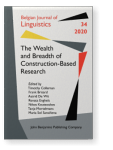Constructional creativity in a Romance language
Valency coercion in Italian
The present contribution summarizes findings on the understudied area of Italian valency coercion – i. e. the interaction of verbs and argument structure constructions in novel and creative ways – from four different studies. It highlights their innovative character, theoretical significance, and crosslinguistic implications for Construction Grammar. The paper suggests that valency coercion resolution involve different phenomena, such as distributional properties of constructions and compatibility between verb and construction. Sociolinguistic factors such as age and diatopic variables are also suggested to be relevant.
Article outline
- 1.Introduction
- 1.1Valency coercion in English and Italian
- 2.Experimental findings on valency coercion in Italian
- 2.1Does valency coercion exist in Italian?
- 2.2How much does construction semantics matter?
- 2.3How much does verb compatibility matter?
- 2.4Coercion and sociolinguistics
- 3.Conclusions
- Notes
-
References
